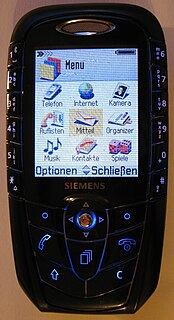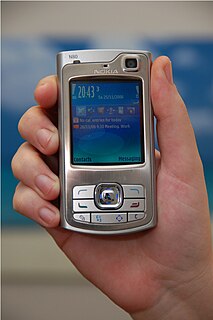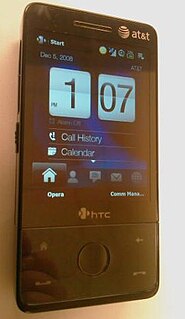
The Siemens SXG75 is a candybar-type UMTS triband mobile phone.
The Universal Mobile Telecommunications System (UMTS) is a third generation mobile cellular system for networks based on the GSM standard. Developed and maintained by the 3GPP, UMTS is a component of the International Telecommunications Union IMT-2000 standard set and compares with the CDMA2000 standard set for networks based on the competing cdmaOne technology. UMTS uses wideband code division multiple access (W-CDMA) radio access technology to offer greater spectral efficiency and bandwidth to mobile network operators.
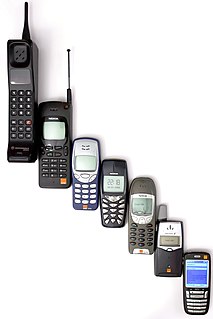
A mobile phone, cell phone, cellphone, or hand phone, sometimes shortened to simply mobile, cell or just phone, is a portable telephone that can make and receive calls over a radio frequency link while the user is moving within a telephone service area. The radio frequency link establishes a connection to the switching systems of a mobile phone operator, which provides access to the public switched telephone network (PSTN). Modern mobile telephone services use a cellular network architecture, and, therefore, mobile telephones are called cellular telephones or cell phones, in North America. In addition to telephony, 2000s-era mobile phones support a variety of other services, such as text messaging, MMS, email, Internet access, short-range wireless communications, business applications, video games, and digital photography. Mobile phones offering only those capabilities are known as feature phones; mobile phones which offer greatly advanced computing capabilities are referred to as smartphones.
This is the first UMTS phone developed by Siemens; previous models (the U10 and the U15) were developed by Motorola. This is also the company's last such device, since the SG75 was cancelled and newer models carried the BenQ-Siemens brand name.
Besides UMTS, it differs from its predecessors in other features:
- Integrated GPS receiver;
- QVGA display (the SX45 was developed by Casio and the SX56 and SX66 were developed by HTC Corporation);
- Brew operating system, capable of multitasking;
- 2 megapixel camera.
An electronic visual display, informally a screen, is a display device for presentation of images, text, or video transmitted electronically, without producing a permanent record. Electronic visual displays include television sets, computer monitors, and digital signage. By the above definition, an overhead projector could reasonably be considered an electronic visual display since it is a display device for the presentation of an images, plain text, or video transmitted electronically without producing a permanent record. They are also ubiquitous in mobile computing applications like tablet computers, smartphones, and information appliances.
The Siemens SX45 is a PDA mobile phone released by Siemens AG in 2002. It was one of the first Pocket PCs with mobile phone functionality. Because of its size and the fact that phone calls could only be made using a headset, it was not really in the same marketing segment as current smartphones.
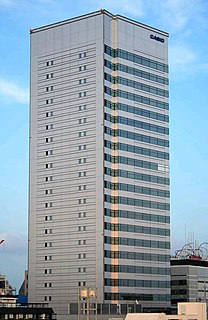
Casio Computer Co., Ltd. is a Japanese multinational consumer electronics and commercial electronics manufacturing company headquartered in Shibuya, Tokyo, Japan. Its products include calculators, mobile phones, digital cameras, electronic musical instruments, and digital watches. It was founded in 1946, and in 1957 released the world's first entirely electric compact calculator. It was an early digital camera innovator, and during the 1980s and 1990s, the company developed numerous affordable home electronic keyboards for musicians.
The phone supports Internet access through GPRS and UMTS, but not EDGE.

Enhanced Data rates for GSM Evolution (EDGE) is a digital mobile phone technology that allows improved data transmission rates as a backward-compatible extension of GSM. EDGE is considered a pre-3G radio technology and is part of ITU's 3G definition. EDGE was deployed on GSM networks beginning in 2003 – initially by Cingular in the United States.

